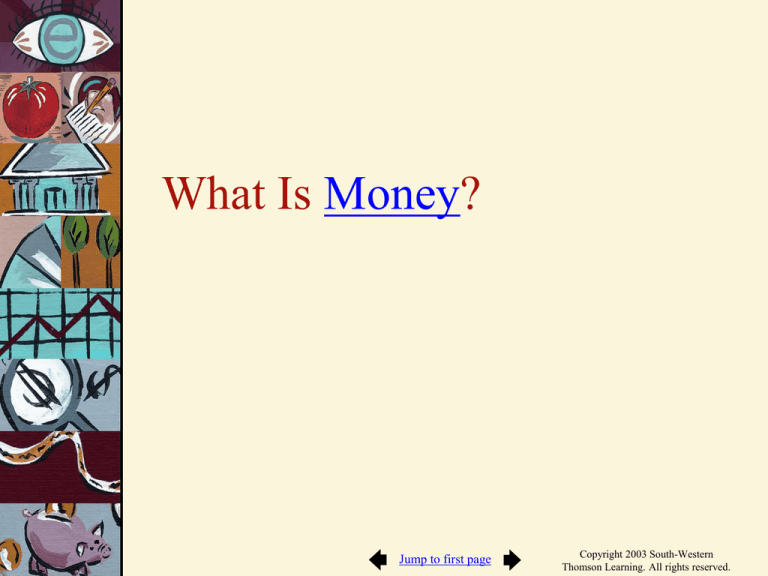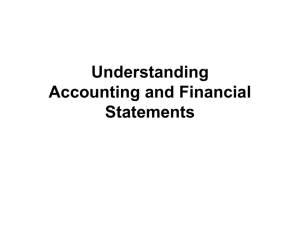
What Is Money?
Jump to first page
Copyright 2003 South-Western
Thomson Learning. All rights reserved.
“Money is whatever is generally
accepted in exchange for goods and
services — accepted not as an object
to be consumed but as an object that
represents a temporary abode of
purchasing power to be used for
buying still other goods and services.”— Milton Friedman
What is overlooked is that already…money latently contains
the opposition between labor and capital. Wage labor on one
side, capital on the other, are therefore, only other forms of
developed exchange value and money. Money thereby
directly and simultaneously becomes the real community,
since it is the general substance of survival for all, and at the
same time the social product of all” K. Marx
Jump to first page
Copyright 2003 South-Western
Thomson Learning. All rights reserved.
What is Money?
• A medium of exchange:
An asset used to buy and sell goods and services.
• A store of value:
An asset that allows people to transfer
purchasing power from one period to another.
• A unit of account:
Units of measurement used by people to post
prices and keep track of revenues and costs.
Jump to first page
Copyright 2003 South-Western
Thomson Learning. All rights reserved.
Why Is Money Valuable?
Jump to first page
Copyright 2003 South-Western
Thomson Learning. All rights reserved.
Why is Money Valuable?
• The main thing that makes money valuable
is the same thing that generates value for
other commodities:
• The demand (for money) relative to its supply.
• People demand money because it reduces the
cost of exchange.
• When the supply of money is limited relative
to the demand, money will be valuable.
Jump to first page
Copyright 2003 South-Western
Thomson Learning. All rights reserved.
The Supply of Money
Jump to first page
Copyright 2003 South-Western
Thomson Learning. All rights reserved.
The Supply of Money
• Two basic measurements of the money
supply are M1 and M2:
• The components of M1 are:
• Currency
• Checking Deposits
(including demand deposits and
interest-earning checking deposits)
• Traveler's checks
• M2 (a broader measure of money) includes:
• M1,
• Savings,
• Time deposits, and,
• Money mutual funds.
Jump to first page
Copyright 2003 South-Western
Thomson Learning. All rights reserved.
Credit Cards Versus Money
• Money is an asset.
• The use of a credit card is merely a
convenient way to arrange for a loan.
• Credit card balances are a liability.
• Thus, credit card purchases are not money.
Jump to first page
Copyright 2003 South-Western
Thomson Learning. All rights reserved.
Ambiguities in the Nature
and Measurement of Money
Jump to first page
Copyright 2003 South-Western
Thomson Learning. All rights reserved.
The Changing Nature of Money
• In the past, economists have often used the
growth rate of the money supply to gauge
the direction of monetary policy.
• rapid growth was indicative of
expansionary monetary policy, while,
• slow growth (or a contraction in the money
supply) was indicative of restrictive policy.
• Recent financial innovations and structural
changes have changed the nature of money
and reduced the reliability of money growth
figures as an indicator of monetary policy.
Jump to first page
Copyright 2003 South-Western
Thomson Learning. All rights reserved.
The Changing Nature of Money
• The introduction of interest earning
checking accounts in the early 1980s
reduced the opportunity cost of holding
checking deposits and thereby changed the
nature of the M1 money supply.
• In the 1990s, many depositors shifted funds
from interest earning checking accounts to
money market mutual funds. Because money
market mutual funds are not included in M1
this also reduced the comparability of the
M1 figures across time periods.
Jump to first page
Copyright 2003 South-Western
Thomson Learning. All rights reserved.
Three Factors Changing the
Nature of Money
• In addition, three other factors are altering
the nature of money and reducing the value
of the money growth figures as an indicator
of monetary policy:
• Widespread use of the dollar abroad:
At least one-half and perhaps as much as
two-thirds of U.S. dollar currency is held
abroad, and these holdings appear to be
increasing. These dollars are included in the
M1 money supply even though they are not
circulating in the U.S..
Jump to first page
Copyright 2003 South-Western
Thomson Learning. All rights reserved.
Three Factors Changing the
Nature of Money
(cont.)
• Increasing availability of low-fee stock
and bond mutual funds:
Because stock and bond mutual funds are not
included in any of the money aggregates,
movement of funds from various M1 and M2
components into these mutual funds will
distort both the M1 and M2 figures.
• Debit cards and electronic money:
Increased use of debit cards and various
forms of electronic money will reduce the
demand for currency. Like other changes in
the nature of money, these innovations will
reduce the reliability of the money supply
figures as an indicator of monetary policy.
Jump to first page
Copyright 2003 South-Western
Thomson Learning. All rights reserved.
Money in the Future
• Electronic money may dramatically alter
the nature of money in the future.
• The introduction of the euro is changing the
nature of money in Europe.
• Several countries (Panama and Ecuador for
example) either directly use the dollar or tie
their domestic currency to the dollar.
• As international trade expands and people
around the world search for access to sound
money, the number of currencies is likely to
decline in the future.
Jump to first page
Copyright 2003 South-Western
Thomson Learning. All rights reserved.
The Changing Nature of M1
2001
Billions of $
1,200
Interest-earning
checkable deposits
$262
1,050
900
Total
$1,203
M1
750
$347
Demand
deposits
600
450
300
$594
Currency
150
1970
1975
1980
1985
1990
1995
2000
• In the 1980s, the introduction of interest-earning checking
accounts caused M1 to grow rapidly.
• In the 1990s, movement of funds from interest-earning
checking deposits to money market mutual funds caused M1
to contract. Thus, the M1 figures are not exactly comparable
across time periods.
Copyright 2003 South-Western
Jump to first page
Thomson Learning. All rights reserved.
Growth Rate of M1 and M2
Annual
% change
M1
15
M2
10
5
0
-5
1970
1975
1980
1985
1990
1995
2000
• Here are the annual growth rates for both the M1 and M2
money supply figures.
• Since the mid-1980’s, the variability of the M1 supply has
been much greater than that for M2 due largely to the
regulatory changes and innovations in financial markets that
have changed the nature of M1.
Jump to first page
Copyright 2003 South-Western
Thomson Learning. All rights reserved.







